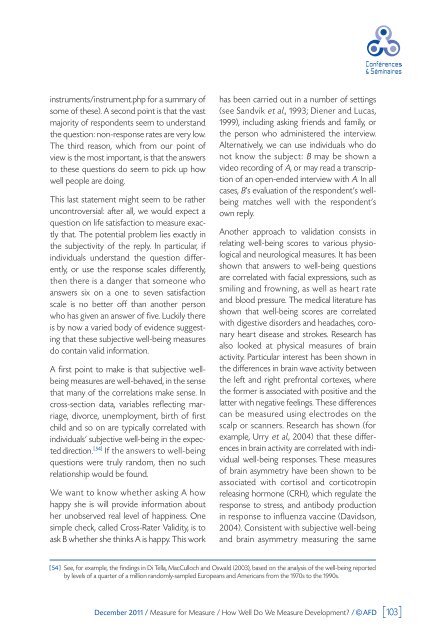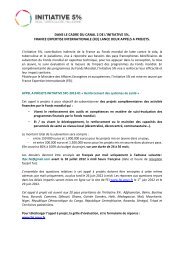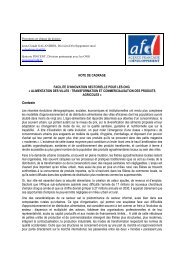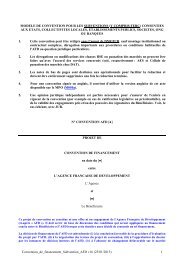Paris School of Economics - L'Agence Française de Développement
Paris School of Economics - L'Agence Française de Développement
Paris School of Economics - L'Agence Française de Développement
Create successful ePaper yourself
Turn your PDF publications into a flip-book with our unique Google optimized e-Paper software.
instruments/instrument.php for a summary <strong>of</strong><br />
some <strong>of</strong> these). A second point is that the vast<br />
majority <strong>of</strong> respon<strong>de</strong>nts seem to un<strong>de</strong>rstand<br />
the question: non-response rates are very low.<br />
The third reason, which from our point <strong>of</strong><br />
view is the most important, is that the answers<br />
to these questions do seem to pick up how<br />
well people are doing.<br />
This last statement might seem to be rather<br />
uncontroversial: after all, we would expect a<br />
question on life satisfaction to measure exactly<br />
that. The potential problem lies exactly in<br />
the subjectivity <strong>of</strong> the reply. In particular, if<br />
individuals un<strong>de</strong>rstand the question differently,<br />
or use the response scales differently,<br />
then there is a danger that someone who<br />
answers six on a one to seven satisfaction<br />
scale is no better <strong>of</strong>f than another person<br />
who has given an answer <strong>of</strong> five. Luckily there<br />
is by now a varied body <strong>of</strong> evi<strong>de</strong>nce suggesting<br />
that these subjective well-being measures<br />
do contain valid information.<br />
A first point to make is that subjective wellbeing<br />
measures are well-behaved, in the sense<br />
that many <strong>of</strong> the correlations make sense. In<br />
cross-section data, variables reflecting marriage,<br />
divorce, unemployment, birth <strong>of</strong> first<br />
child and so on are typically correlated with<br />
individuals’ subjective well-being in the expected<br />
direction. [ 54] If the answers to well-being<br />
questions were truly random, then no such<br />
relationship would be found.<br />
We want to know whether asking A how<br />
happy she is will provi<strong>de</strong> information about<br />
her unobserved real level <strong>of</strong> happiness. One<br />
simple check, called Cross-Rater Validity, is to<br />
ask B whether she thinks A is happy. This work<br />
has been carried out in a number <strong>of</strong> settings<br />
(see Sandvik et al., 1993; Diener and Lucas,<br />
1999), including asking friends and family, or<br />
the person who administered the interview.<br />
Alternatively, we can use individuals who do<br />
not know the subject: B may be shown a<br />
vi<strong>de</strong>o recording <strong>of</strong> A, or may read a transcription<br />
<strong>of</strong> an open-en<strong>de</strong>d interview with A. In all<br />
cases, B’s evaluation <strong>of</strong> the respon<strong>de</strong>nt’s wellbeing<br />
matches well with the respon<strong>de</strong>nt’s<br />
own reply.<br />
Another approach to validation consists in<br />
relating well-being scores to various physiological<br />
and neurological measures. It has been<br />
shown that answers to well-being questions<br />
are correlated with facial expressions, such as<br />
smiling and frowning, as well as heart rate<br />
and blood pressure. The medical literature has<br />
shown that well-being scores are correlated<br />
with digestive disor<strong>de</strong>rs and headaches, coronary<br />
heart disease and strokes. Research has<br />
also looked at physical measures <strong>of</strong> brain<br />
activity. Particular interest has been shown in<br />
the differences in brain wave activity between<br />
the left and right prefrontal cortexes, where<br />
the former is associated with positive and the<br />
latter with negative feelings. These differences<br />
can be measured using electro<strong>de</strong>s on the<br />
scalp or scanners. Research has shown (for<br />
example, Urry et al., 2004) that these differences<br />
in brain activity are correlated with individual<br />
well-being responses. These measures<br />
<strong>of</strong> brain asymmetry have been shown to be<br />
associated with cortisol and corticotropin<br />
releasing hormone (CRH), which regulate the<br />
response to stress, and antibody production<br />
in response to influenza vaccine (Davidson,<br />
2004). Consistent with subjective well-being<br />
and brain asymmetry measuring the same<br />
[54] See, for example, the findings in Di Tella, MacCulloch and Oswald (2003), based on the analysis <strong>of</strong> the well-being reported<br />
by levels <strong>of</strong> a quarter <strong>of</strong> a million randomly-sampled Europeans and Americans from the 1970s to the 1990s.<br />
December 2011 / Measure for Measure / How Well Do We Measure Development? / © AFD [ 103]

















